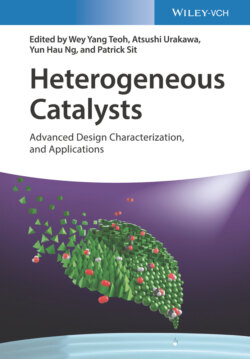Читать книгу Heterogeneous Catalysts - Группа авторов - Страница 77
6.2.2.3 Identification of Catalytically Active Sites
ОглавлениеA thorough understanding of the nature of CASs is helpful for improving existing catalysts and designing superior new catalysts [27, 28]. However, the precise identification of CASs of supported metal NP catalysts is challenging. Fujitani and Nakamura found that the CASs of Au/TiO2 for CO oxidation are temperature dependent [29]. At low reaction temperatures the CASs are located at the perimeter interfaces of the Au NPs in contact with TiO2 support, whereas at high temperatures all the surface Au atoms can act as CASs. Ertl's group reported that active metal surfaces are often oscillating during catalytic oxidation [30], meaning that CASs can be changeable.
On the contrary, it is straightforward to identify the CASs of SACs because the single metal atoms in contact with their immediate neighboring atoms of the support surfaces are usually CASs. For example, Yang et al. [31] reported that at higher gold loadings, both gold atoms and NPs existed on titania. After leaching gold NPs by a sodium cyanide solution, the atomically dispersed gold still bound on titania and the catalytic activity in the WGS reaction was intact. Hence, the atomically dispersed gold species with surrounding surface −OH groups should be the CASs in this case. Similar results were reported in other reactions [32, 33]. Therefore, it is easier to study the nature of the CASs by comparing different SACs. We synthesized two thermally stable SACs by two methods, and single Ag atoms were found to be anchored at the {001} top facets of hollandite‐type manganese oxide (HMO) (Figure 6.3a–d). One SAC denoted as AgAOR‐HMO was prepared, starting from a supported Ag (particle) sample, by thermal diffusion [34]. The other SAC denoted as AgIMP‐HMO was prepared by wet impregnation with AgNO3 as a precursor. Thus we can establish the correlation between the electronic structure of CASs and activity by studying the structure and catalytic performance of two single‐atom silver catalysts. Our results showed that the higher depletion of the 4d electronic states of the Ag atoms caused stronger electronic metal–support interactions, leading to easier reducibility of the sample and higher catalytic activity for formaldehyde (HCHO) oxidation [34]. In another work, single‐atom sodium and silver catalysts were also used to differentiate the function of alkalis from that of noble metals under identical conditions [35]. Wang et al. also established a quantitative correlation between the catalytic performance (in NH3BH3 hydrolysis to generate H2) and metal–support interactions by using Rh1/VO2 catalysts [36].
Figure 6.3 High‐resolution TEM and energy dispersive X‐ray (EDX) line scans along the yellow lines of AgAOR‐HMO (a, c) and AgIMP‐HMO (b, d). In the structural models, an oxygen atom is represented by a pink ball (c, d), and a silver atom is represented by a yellow ball (c) or a gray ball (d). Scale bars: 1 nm (a, b), 40 nm (c, d).
Source: Hu et al. 2014 [34]. Reproduced with permission of John Wiley & Sons.
(See online version for color figure).
